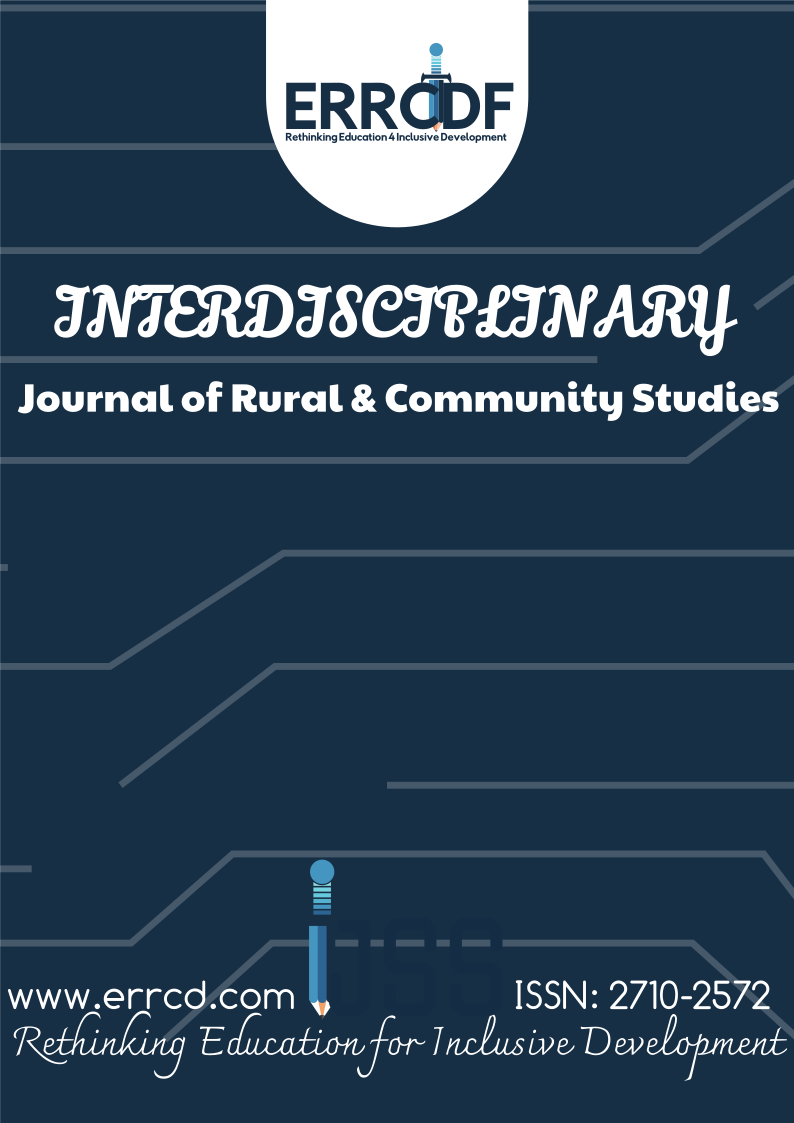Reimagining family re-unification: Exploring strategies for reintegrating street children in Harare, Zimbabwe
DOI:
https://doi.org/10.38140/ijrcs-2024.vol7.1.08Keywords:
Street children, families, reintegration, social development officers, ZimbabweAbstract
The phenomenon of street children in Harare, Zimbabwe, presents a significant social challenge, necessitating effective family reunification strategies. This research paper explores methods to reintegrate street children in Harare into their families, using Rational Emotive Behaviour Theory as a theoretical lens. The study utilised a qualitative research approach, employing a phenomenological research design. The population comprised ten social development officers involved in integrating street children into their families of origin. A purposive sample of ten social development officers located in the Harare Metropolitan Province participated in the study. A semi-structured interview schedule was used to collect data, which was analysed using thematic analysis. The findings underscore the critical need for innovative strategies that prioritise the effective reintegration of street children into their families. Key findings highlight the root causes of street children's homelessness and the use of several innovative strategies, such as family conferences, community engagement, psychosocial support, counselling, and providing families with resources as essential for the effective integration of street children into their original families. Based on the findings of the study, counselling and psychosocial support, community engagement, family conferences, and addressing the underlying causes of street child homelessness are recommended. The study contributes by deepening our understanding of the complex factors that lead to children being on the street and how addressing those factors could ensure effective integration of street children into families. It serves as a valuable resource for policymakers, social development officers, and researchers seeking to tackle the issue of child homelessness and family reintegration.
References
Alem, H. W., & Laha, A. (2016). Livelihood of street children and the role of social intervention: Insights from literature using meta-analysis. Child Development Research, 2016, 1–13. https://doi.org/10.1155/2016/3582101
Ashford, J. B., & LeCroy, C. W. (2010). Human behaviour in the social environment: A multidimensional perspective. Cengage Learning.
Adewale, S., & Potokri, O. C. (2023). Assessment of child protection policy awareness in secondary schools. EUREKA: Social and Humanities, 3, 20–30. https://doi.org/10.21303/2504-5571.2023.002866
Babbie, E. (2012). The practice of social research. Wadsworth Cengage Learning.
Balsells, M., Pastor, C., Amorós, P., Mateos, A., Ponce, C., & Navajas, A. (2014). Child welfare and successful reunification through the socio-educative process: Training needs among biological families in Spain. Social Sciences, 3(4), 809–826. https://doi.org/10.3390/socsci3040809
Bridges, K. R., & Harnish, R. J. (2010). Role of irrational beliefs in depression and anxiety: A review. Health,2(8). https://doi.org/10.4236/health.2010.28130
Chartier, S., & Blavier, A. (2021). Should the reintegration of children in foster care into their biological families be the only goal of the legislation governing foster care? Factors influencing the relations between parents and their children living in foster care. Children and Youth Services Review, 1-7. https://doi.org/10.1016/j.childyouth.2020.105741
Chege, N., & Ucembe, S. (2020). Kenya’s over-reliance on institutionalisation as a child care and child protection model: A root-cause approach. Social Sciences, 9(4), 57. https://doi.org/10.3390/socsci9040057
Cheserek, S. K., & Kavivya, C. (2022). Relationship between street children and crime: A case of Nairobi City County, Kenya. The Strategic Journal of Business & Change Management,9(2), 1453–1478.
Creswell, J. W., & Creswell, J. D. (2018). Research design: Qualitative, quantitative, and mixed method approaches. Sage.
Kudenga, M., Heeralal, P., & Ndwandwe, N. (2024). Navigating the road home: Challenges hindering the reintegration of street children with their families in Harare, Zimbabwe. Interdisciplinary Journal of Rural and Community Studies, 6, 1–13. https://doi.org/10.38140/ijrcs-2024.vol6.07
Font, S. A., Sattler, K. M. P., & Gershoff, E. (2018). When home is still unsafe: From family reunification to foster care reentry. Journal of Marriage and Family, 80, 1333–1343. https://doi.org/10.1111/jomf.12499
Fraser, M. W., Richman, J. M., Galinsky, M. J., & Day, S. H. (2009). Intervention research: Developing social programs. Oxford University Press.
Friberg, A., & Martinsson, V. (2017). Problems and solutions when dealing with street children: A qualitative study based on experiences from social workers in Bloemfontein, South Africa [Master's dissertation, Jönköping University]. Jönköping University.
Frimpong-Manso, K., Agbadi, P., & Deliege, A. (2022). Factors associated with the family reintegration stability for children with a residential care experience in Ghana. Global Studies of Childhood, 12(1), 56–69. https://doi.org/10.1177/20436106221077699
Goodman, M. L., Gibson, D. C., Baker, L., & Seidel, S. E. (2020). Family-level factors to reintegrate street-involved children in low- and middle-income countries: A scoping review. Children and Youth Services Review, 109, 104664.
Halton, L. (2022). Family reunification and child rights of children in street situations in Uganda and the Gambia. Consortium of Street Children. https://www.streetchildren.org/resources/family-reunification-and-the-rights-of-children-in-street-situations-in-uganda-and-the-gambia/
Heimisson, G. T. (2011). A cross-cultural adaptation of the Irrational Beliefs Inventory from English to Icelandic [Graduate theses and dissertations, University of South Florida].
Iannelli, A. M., Assis, S. G., & Pinto, L. W. (2013). Family reintegration of children and adolescents in foster care in Brazilian municipalities with different population sizes. Centro Latino Americano de Estudos de Violencia e Saúde, Lorge Careli, Escola Fiocruz, Av. Brazil 4036, Manguinhos 21040-361.
Kakilla, C. (2021). Strengths and weaknesses of semi-structured interviews in qualitative research methods: A critical essay. https://doi.org/10.20944/preprints202106.0491.v1
Kakuru, R., Rukooko, A. B., & Tusabe, G. (2019). Social protection mechanisms for children living on the streets: Perspectives from Uganda. Journal of African Studies and Development, 11(1), 1–11. https://doi.org/10.5897/JA2018.0523
Kibet, N. (2020). Street-connected children: Experiences of reintegration programs – a case of Eldoret, Kenya. Master's dissertation, Tampere University.
Kuehr, M. E. (2015). Rwanda’s orphan care and integration during uncertain times. Stability: International Journal of Security and Development, 4(1), 1–15. https://doi.org/10.5334/sta.fg
Kumar, R. (2019). Research methodology: A step-by-step guide for beginners in research. Sage.
Kurevakwesu, W., & Chizasa, S. (2020). Ubuntu and child welfare policy in Zimbabwe: A critical analysis of the National Orphans Care Policy’s six-tier system. African Journal of Social Work, 10(1), 89–94.
Manjengwa, J., Matema, C., Tirivanhu, D., & Tizora, R. (2016). Deprivation among children living and working on the streets of Harare. Development Southern Africa, 33(1), 53–66. https://doi.org/10.1080/0376835x.2015.1115337
Mella, M. (2012). An investigation into the nature and extent of the economic exploitation of street children in Zimbabwe: A case study of Harare Central Business District [Master’s dissertation, University of Zimbabwe, Harare].
Muchinako, G. A., Mpambela, M., & Muzingili, T. (2018). The time for reflection: Foster care as a protection model in Zimbabwe. African Journal of Social Work, 8(2), 38–45.
Musekiwa, M. (2009). Working for survival: Children engaged in economic activities on the streets of Harare (Master’s dissertation). University of Zimbabwe, Harare.
Najafi, T., Jamaluddin, S., & Lea-Baranovich, D. (2012). Effectiveness of group REBT in reducing irrational beliefs in two groups of Iranian female adolescents living in Kuala Lumpur. Interdisciplinary Journal of Contemporary Research in Business, 3(12), 312–322.
Nathan, M. A., & Fratkin, E. (2018). The lives of street women and children in Hawassa, Ethiopia.African Studies Review, 61(1), 158–184. https://doi.org/10.1017/asr.2017.135
Ndlovu, E., & Tigere, R. (2022). Life in the streets, children speak out: A case of Harare Metropolitan, Zimbabwe. African Journal of Social Sciences and Humanities Research, 5(1), 25–45. https://doi.org/10.52589/ajsshr-fdxcdat2
Ngulube, L. (2010). A study on the sexual and reproductive health challenges faced by adolescents participating in the Streets Ahead programmes in Harare (Master’s dissertation). University of Zimbabwe, Harare.
Obimakinde, A. M., & Shabir, M. (2023). Recount and account of lived experience of children on the street: A phenomenology approach. International Journal of Qualitative Research, 2(3), 183–194. https://doi.org/10.47540/ijqr.v2i3.756
Ogan, E. P. (2021). Dynamics of street children in Africa. https://www.researchgate.net/publication/348539465_DYNAMICS_OF_STREET_CHILDREN_IN_AFRICA
Ogutu, M. (2020). Under the bridge: The invisible lives of street children. https://www.mandelarhodes.org/ideas/under-the-bridge-the-invisible-lives-of-street-children/
Ogunkan, D. V. (2024). The dynamics of street children in Nigerian cities: The significance of age and gender. Journal of Gender Studies, 1–18. https://doi.org/10.1080/09589236.2024.2376428
Onuigbo, L. N., Eseadi, C., Ugwoke, S. C., Nwobi, A. U., Anyanwu, J. I., Okeke, F. C., Agu, P. U., Oboegbulem, A. I., Chinweuba, N. H., Agundu, U. V., Ololo, K. O., Okpoko, C., Nwankwor, P. P., Eze, U. N., & Eze, P. (2018). Effect of rational emotive behaviour therapy on stress management and irrational beliefs of special education teachers in Nigerian elementary schools. Medicine, 97(37), e12191. https://doi.org/10.1097/md.0000000000012191
Onyiko, K., & Pechacova, D. (2015). The impact of institutionalisation of street children: A case study of Nairobi County. Research on Humanities and Social Sciences, 5(8), 160–182.
Paul, B., & Paul, V. (2020). Factors of reintegration of children in conflict with the law. Journal of Dharma, 45(1), 105–124.
Paz-Soldan, V. A., Reiner, R. C., Morrison, A. C., Stoddard, S. T., Kitron, U., Scott, T. W., Elder, J. P., Halsey, E. S., Kochel, T. J., Astete, H., & Vazquez-Prokopec, G. M. (2014). Strengths and weaknesses of global positioning system (GPS) data-loggers and semi-structured interviews for capturing fine-scale human mobility: Findings from Iquitos, Peru. PLoS Neglected Tropical Diseases, 8(6), e2888. https://doi.org/10.1371/journal.pntd.0002888
Qutoshi, S. B. (2018). Phenomenology: A philosophy and method of inquiry. Journal of Education and Educational Development, 5(1), 215–222. https://doi.org/10.22555/joeed.v5i1.2154
Ringson, J., & Chereni, A. (2020). Efficacy of the extended family system in supporting orphans and vulnerable children in Zimbabwe: An indigenous knowledge perspective. African Journal of Social Work, 10(1), 99–108.
Rosner, R. (2011). Albert Ellis’ rational-emotive behaviour therapy. Adolescent Psychiatry, 1(1), 82–87.
Sahin, E. S., & Acar, N. V. (2019). Rational-emotive behaviour therapy from a new perspective. International Journal of Human Sciences, 16(4), 894–906. http://dx.doi:10.14687/jhs.v16i4.5821
Schrader-McMillan, A., & Herrera, E. (2016). The successful family reintegration of street-connected children: Application of attachment and trauma theory. Journal of Children’s Services, 11(3), 217–232.
Sherr, L., Roberts, K. J., & Gandhi, N. (2017). Child violence experiences in institutionalised. Psychology, Health & Medicine, 22(sup1), 31–57. https://doi.org/10.1080/13548506.2016.1271951
Here is the list in APA 7th edition style with the necessary corrections made:
Sitienei, E. C., & Pillay, J. (2018). Life experiences of children living on streets in Kenya: From the pot into the fire. Journal of Child & Adolescent Trauma, 12(2), 201–209. https://doi.org/10.1007/s40653-018-0226-8
Smith, J. A. (2014). Qualitative psychology: A practical guide to research methods. Sage.
Smith, K., & Wakia, J. (2012). Family reintegration for children living in the streets. http://www.retrak.org/uploaded/Retrak%20Technical%20Brief%20Family%20reintegration%20K%20Smith%20&%20J%20Wakia%20July%202012%20%28web%20version%29.pdf
Turner, M. J. (2016). Rational emotive behaviour therapy (REBT), irrational and rational beliefs, and the mental health of athletes. Frontiers in Psychology, 7, 1423. https://doi.org/10.3389/fpsyg.2016.01423
Ulusoy, Y., & Duy, B. (2013). Effectiveness of a psycho-education program on learned helplessness and irrational beliefs. Educational Sciences: Theory and Practice, 13(3), 1440–1446. https://doi.org/10.12738/estp.2013.3.1469
UNESCO. (2017). Education for sustainable development goals: Learning objectives. United Nations Educational, Scientific and Cultural Organisation. https://unesdoc.unesco.org/ark:/48223/pf0000247444
UN-Habitat. (2022). The state of African cities 2022: Urban governance for inclusion and sustainability. United Nations Human Settlements Programme.
Zewude, B., Siraw, G., Engdawork, K., & Tadele, G. (2023). Health-seeking behaviour of street-connected children in Addis Ababa, Ethiopia. Frontiers in Sociology, 8, Article 1188746. https://doi.org/10.3389/fsoc.2023.1188746
Downloads
Published
How to Cite
Issue
Section
License
Copyright (c) 2025 Mugove Kudenga, Prem Heeralal, Ntokozo Dennis Ndwandwe

This work is licensed under a Creative Commons Attribution 4.0 International License.






